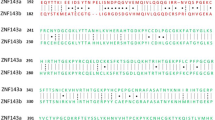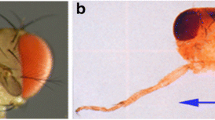Abstract
Enhancers of yellow (e(y)) is a group of genetically and functionally related genes. The proteins encoded by these genes are involved in transcription regulation. The e(y)3 gene under study codes for an ubiquitous nuclear protein, termed SAYP, which has homologs in various multicellular organisms. SAYP contains an AT-hook domain, two PHD domains, and a new evolutionarily conserved domain. SAYP mutants die during embryonic development. The weak e(y) ul mutation causes multiple malformations. The potent e(y) EMSl mutation causes embryonic death, implicating SAYP in early development.
Similar content being viewed by others
REFERENCES
George, C.P., Lira-DeVito, L.M., Wampler, S.L., et al., A Spectrum of Mechanisms for the Assembly of the RNA Polymerase II Transcription Preinitiation Complex, Mol. Cell. Biol., 1995, vol. 15, pp. 1049–1059.
Bell, B. and Tora, L., Regulation of Gene Expression by Multiple Forms of TFIID and Other Novel TAFII-Containing Complexes, Exp. Cell Res., 1999, vol. 246, pp. 11–19.
Lee, T.I. and Young, R.A., Regulation of Gene Expression by TBP-Associated Proteins, Genes Dev., 1998, vol. 12, pp. 1398–1408.
Georgiev, P.G. and Gerasimova, T.I., Novel Genes Influencing the Expression of the yellow Locus and mdg4 (gypsy) in Drosophila melanogaster, Mol. Gen. Genet., 1989, vol. 220, pp. 121–126.
Soldatov, A., Nabirochkina, E., Georgieva, S., et al., TAFII40 Protein Is Encoded by the e(y)1 Gene: Biological Consequences of Mutations, Mol. Cell. Biol., 1999, vol. 19, pp. 3769–3778.
Georgieva, S., Nabirochkina, E., Dilworth, F.J., et al., The Novel Transcription Factor e(y)2 Interacts with TAF(II)40 and Potentiates Transcription Activation on Chromatin Templates, Mol. Cell. Biol., 2001, vol. 21, pp. 5223–5231.
Georgiev, P.G., Identification of Mutations in Three Genes That Interact with zeste in the Control of white Gene Expression in Drosophila melanogaster, Genetics, 1994, vol. 138, pp. 733–739.
Kozitsina, M.V. and Georgiev, P.G., Construction and Analysis of New Mutations of the mod(mdg4) Gene in Drosophila melanogaster, Genetika (Moscow), 1992, vol. 28, no.10, pp. 75–82.
Rubin, G.M. and Spradling, A.C., Genetic Transformation of Drosophila with Transposable Element Vectors, Science, 1982, vol. 218, pp. 348–353.
Spradling, A.C. and Rubin, G.M., Transposition of Cloned P Elements into Drosophila Germ Line Chromosomes, Science, 1982, vol. 218, pp. 341–347.
Georgieva, S.G., Nabirochkina, E.N., Georgiev, P.G., et al., The Drosophila melanogaster enhancer of yellow 1 Gene Codes for TAFII40, Dokl. Akad. Nauk, 2000, vol. 375, pp. 228–230.
Maes, M. and Messens, E., Phenol As Grinding Material in RNA Preparations, Nucleic Acids Res., 1992, vol. 20, p. 4374.
Sandaltzopoulos, R., Quivy, J.P., and Becker, P.B., Analysis of Protein-DNA Interactions by Solid-Phase Footprinting, Methods Mol. Cell. Biol., 1995, vol. 5, pp. 176–181.
Altschul, S.F., Madden, T.L., Schaffer, A.A., et al., Gapped BLAST and PSI-BLAST: A New Generation of Protein Database Search Programs, Nucleic Acids Res., 1997, vol. 25, pp. 3389–3402.
Corpet, F., Multiple Sequence Alignment with Hierarchical Clustering, Nucleic Acids Res., 1988, vol. 16, pp. 10 881–10 890.
Georgiev, P.G., Kiselev, S.L., Simonova, O.B., et al., A Novel Transposition System in Drosophila melanogaster Depending on the Stalker Mobile Genetic Element, EMBO J., 1990, vol. 9, pp. 2037–2044.
Aravind, L. and Landsman, D., AT-Hook Motifs Identified in a Wide Variety of DNA-Binding Proteins, Nucleic Acids Res., 1998, vol. 26, pp. 4413–4421.
Mazo, A.M., Huang, D.H., Mozer, B.A., et al., The trithorax Gene, a Trans-Acting Regulator of the bithorax Complex in Drosophila, Encodes a Protein with Zinc-Binding Domains, Proc. Natl. Acad. Sci. USA, 1990, vol. 87, pp. 2112–2116.
DeCamillis, M., Cheng, N.S., Pierre, D., et al., The Polyhomeotic Gene of Drosophila Encodes a Chromatin Protein That Shares Polytene Chromosome-Binding Sites with Polycomb, Genes Dev., 1992, vol. 6, pp. 223–232.
Kalkhoven, E., Teunissen, H., Houweling, A., et al., The PHD Type Zinc Finger Is an Integral Part of the CBP Acetyltransferase Domain, Mol. Cell. Biol., 2002, vol. 22, pp. 1961–1970.
Wade, P.A., Gegonne, A., Jones, P.L., et al., Mi-2 Complex Couples DNA Methylation to Chromatin Remodeling and Histone Deacetylation, Nat. Genet., 1999, vol. 23, pp. 62–66.
Ito, T., Levenstein, M.E., Fyodorov, D.V., et al., ACF Consists of Two Subunits, Acf1 and ISWI, That Function Cooperatively in the ATP-Dependent Catalysis of Chromatin Assembly, Genes Dev., 1999, vol. 13, pp. 1529–1539.
Rebhan, M., Chalifa-Caspi, V., Prilusky, J., et al., Gene-Card for PHF10, GeneCards: Encyclopedia for Genes, Proteins and Diseases, Weizmann Institute of Science, Bioinformatics Unit and Genome Center (Rehovot, Israel), 1997.
Author information
Authors and Affiliations
Additional information
__________
Translated from Genetika, Vol. 41, No. 8, 2005, pp. 1027–1032.
Original Russian Text Copyright © 2005 by Shidlovskii, Nikolenko, Krasnov, Kopantseva, Georgieva, Nabirochkina.
Rights and permissions
About this article
Cite this article
Shidlovskii, Y.V., Nikolenko, J.V., Krasnov, A.N. et al. The e(y)3 Gene Codes for SAYP, an Evolutionary Conserved Protein That Is Essential for Ontogeny. Russ J Genet 41, 835–839 (2005). https://doi.org/10.1007/s11177-005-0168-8
Received:
Issue Date:
DOI: https://doi.org/10.1007/s11177-005-0168-8




